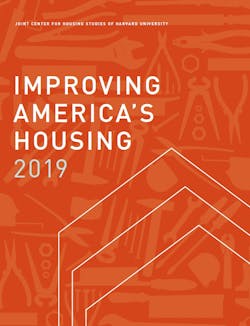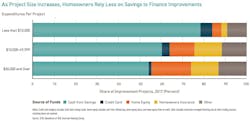“With new construction slowly recovering from historic lows, 40% of the country’s 137 million homes are at least 50 years old,” said Abbe Will, associate project director in the Remodeling Futures Program. “The aging of the housing stock has been a boon to the remodeling industry, with spending surpassing investment in homebuilding every year for over a decade.”
The steady uptick in house prices in many markets and the aging population are also driving increased spending on home improvements and repairs. Additionally, older households have higher homeownership rates than younger households, and many have the resources to afford major renovations. Households 55 and over account for half of all improvement spending by homeowners today.
Expanding the ability of owners to pay for improvement projects over time would generate considerable growth in the remodeling industry and help preserve and modernize the nation’s aging housing stock. Source: JCHS Improving America's Housing 2019.
At the same time, the number of owners under 35 is finally showing signs of a rebound following the housing crash, and so is their remodeling spending. With homeownership recovering, almost 7 million rental and vacant units were converted to owner occupancy in 2016 and 2017, and their owners invested $50 billion in improvements.
“Over the next decade, the strong preference of older homeowners to age in place and the increasing difficulty of building affordable housing in many markets will continue to hinder the construction of new homes,” said Kermit Baker, director of the Remodeling Futures Program and a Pro Remodeler Thought Leader. “The remodeling industry will therefore retain its critical role in helping the country meet its housing needs.”

